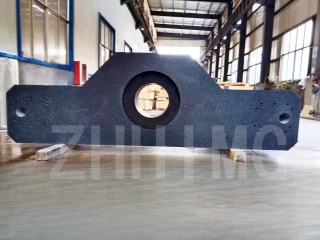In modern industrial applications, linear motors are widely used in automation, robotics and transportation for their high precision and high efficiency characteristics. Granite, as a natural stone with high hardness, wear-resistant and not easy to deform, is also widely used in the manufacture of precision equipment, especially in the application of linear motors requiring high-precision control. However, the surface treatment of granite has a significant impact on its performance in linear motor applications.
First of all, let's discuss the surface treatment of granite. Common granite treatment methods include polishing, fire, sand blasting, water knife cutting marks, etc. Each of these treatments has its own characteristics and can create different textures and textures on the granite surface. However, for linear motor applications, we are more concerned about the impact of surface treatment on the physical properties of granite, such as surface roughness, friction coefficient and so on.
In linear motor applications, granite is often used as a support or guide material for moving parts. Therefore, its surface roughness and friction coefficient have a direct impact on the motion accuracy and stability of linear motor. In general, the smaller the surface roughness, the lower the friction coefficient, the higher the motion accuracy and stability of the linear motor.
Polishing treatment is a treatment method that can significantly reduce the surface roughness and friction coefficient of granite. By grinding and polishing, the granite surface can become very smooth, thus reducing the friction resistance between the moving parts of the linear motor. This treatment is particularly important in linear motor applications that require high precision control, such as semiconductor manufacturing, optical instruments and other fields.
However, in some special application scenarios, we may want the granite surface to have a certain roughness to increase the friction between the moving parts of the linear motor. At this time, fire, sand blasting and other treatment methods can come in handy. These treatments can form a certain texture and texture on the granite surface and increase the friction between the moving parts, thereby improving the stability and reliability of the linear motor.
In addition to surface roughness and friction coefficient, the thermal expansion coefficient of granite is also an important factor affecting its performance in linear motor applications. Because the linear motor will produce a certain amount of heat during the working process, if the thermal expansion coefficient of granite is too large, it will lead to a large deformation when the temperature changes, and then affect the motion accuracy and stability of the linear motor. Therefore, when selecting granite materials, we also need to consider the size of its thermal expansion coefficient.
In summary, the surface treatment of granite has a significant impact on its performance in linear motor applications. When choosing granite materials, we need to choose the appropriate treatment according to the specific application scenarios and requirements to ensure the high-precision and high-efficiency operation of the linear motor.
Post time: Jul-15-2024

